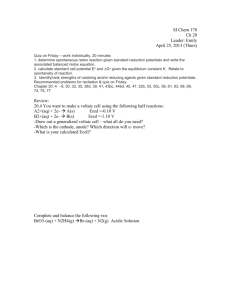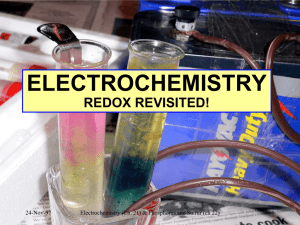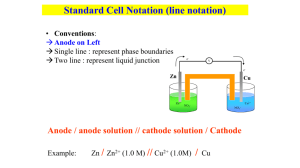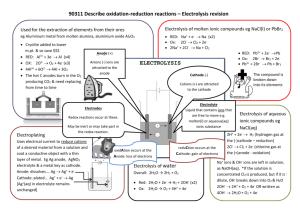Chapter 20
advertisement
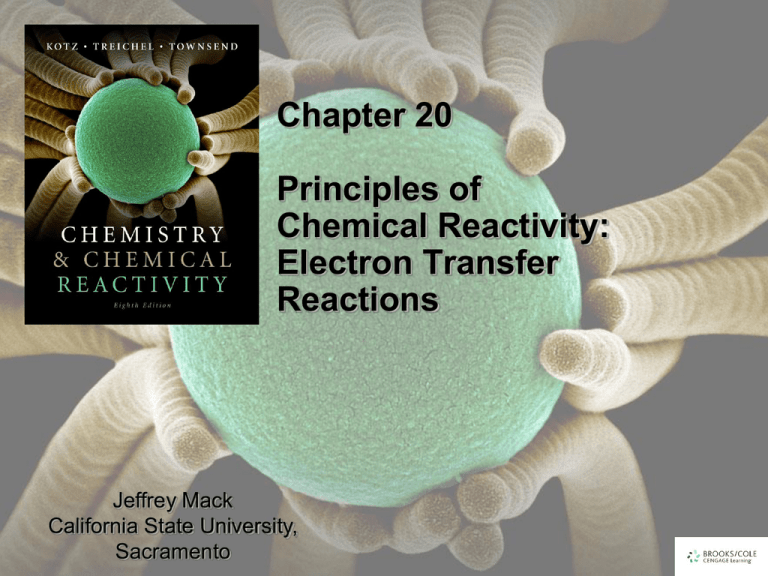
Chapter 20 Principles of Chemical Reactivity: Electron Transfer Reactions Jeffrey Mack California State University, Sacramento Electron Transfer Reactions • Electron transfer reactions are oxidationreduction or redox reactions. • Redox reactions can result in the generation of an electric current or be caused by imposing an electric current. • Therefore, this field of chemistry is often called ELECTROCHEMISTRY. Review of Terminology for Redox Reactions • OXIDATION: loss of electron(s) by a species; increase in oxidation number. • REDUCTION: gain of electron(s); decrease in oxidation number. • OXIDIZING AGENT: electron acceptor; species is reduced. • REDUCING AGENT: electron donor; species is oxidized. Electrochemistry Applications: • Batteries • Corrosion • Industrial production of chemicals such as Cl2, NaOH, F2 and Al • Biological electron transfer reactions The heme group Electrochemical Cells • An apparatus that allows an electron transfer reaction to occur via an external connector. • Voltaic or galvanic cells: Reactions that produce a chemical current that are product favored • Electrolytic cell: Reactions which require an electric current to cause chemical change. (reactant favored) Batteries are voltaic cells Electrochemistry Pioneers Alessandro Volta, 17451827, Italian scientist and inventor. Luigi Galvani, 1737-1798, Italian scientist and inventor. Oxidation/Reduction Reactions Cu(s) + 2Ag+ (aq) Cu2+ (aq) + 2Ag(s) Oxidation-Reduction Reactions: “Redox” Direct Redox Reaction Oxidizing and reducing agents in direct contact. Cu(s) + 2 Ag+(aq) Cu2+(aq) + 2 Ag(s) Oxidation-Reduction Reactions: “Redox” Indirect Redox Reaction A battery functions by transferring electrons through an external wire from the reducing agent to the oxidizing agent. Oxidation-Reduction Reactions: “Redox” In any Oxidation Reduction reaction: • One species is Oxidized and one species is Reduced. • Neither can occur alone. • That which is reduced is the Oxidizing Agent. • That which is Oxidized is the Reducing Agent. • The total number of electrons lost in oxidation must equal the total number of electrons gained in reduction. • Redox reactions must therefore be balanced for mass and charge. Balancing Redox Equations Step 1: Divide the reaction into half-reactions, one for oxidation and the other for reduction. Ox Cu(s) Cu2+(aq) Red Ag+(aq) Ag(s) Step 2: Balance each for mass. Already done in this case. Step 3: Balance each half-reaction for charge by adding electrons. Ox Cu(s) Cu2+(aq) + 2e Red Ag+(aq) + e Ag(s) Balancing Redox Equations Step 4: Multiply each half-reaction by a factor so that the reducing agent supplies as many electrons as the oxidizing agent requires. Reducing agent: Cu(s) Cu2+ (aq) + 2e Oxidizing agent: 2Ag+(aq) + 2e 2Ag(s) Step 5: Add half-reactions to give the overall equation. Cu(s) + 2 Ag+(aq) Cu2+(aq) + 2Ag(s) The equation is now balanced for both charge and mass. Balancing Equations for Redox Reactions Some redox reactions have equations that must be balanced by special techniques MnO4- + 5 Fe2+ + 8 H+ Mn2+ + 5 Fe3+ + 4 H2O Mn = +7 Fe = +2 Mn = +2 Fe = +3 Reduction of + VO2 by Zn Balancing Redox Equations Balance the following in acid solution: VO2+ + Zn VO2+ + Zn2+ Step 1: Write the half-reactions Ox Zn Zn2+ Red VO2+ VO2+ Step 2: Balance each half-reaction for mass. Ox Zn Zn2+ 2 H+ + VO2+ VO2+ + H2O Red Add H2O on O-deficient side and add H+ on other side for Hbalance. Balancing Redox Equations Step 3: Ox Red Step 4: Ox Red Step 5: Balance half-reactions for charge. Zn Zn2+ + 2ee- + 2 H+ + VO2+ VO2+ + H2O Multiply by an appropriate factor. Zn Zn2+ + 2e2e- + 4 H+ + 2 VO2+ 2 VO2+ + 2 H2O Add balanced half-reactions Zn + 4 H+ + 2 VO2+ Zn2+ + 2 VO2+ + 2 H2O Tips on Balancing Redox Reaction Equations • Never add O2, O atoms, or O2- to balance oxygen. • Never add H2 or H atoms to balance hydrogen. • Be sure to write the correct charges on all the ions. • Check your work at the end to make sure mass and charge are balanced. • PRACTICE! Chemical Change & Electric Current With time, Cu plates out onto Zn metal strip, and Zn strip “disappears.” Electrons are transferred from Zn to Cu2+, but there is no useful electric current. Oxidation: Zn(s) Zn2+(aq) + 2eReduction: Cu2+(aq) + 2e- Cu(s) -------------------------------------------------------Cu2+(aq) + Zn(s) Zn2+(aq) + Cu(s) Chemical Change & Electric Current • To obtain a current that can do work, the oxidizing and reducing agents are separated so that electron transfer occurs via an external wire. This is accomplished in a GALVANIC or VOLTAIC cell. A group of such cells is called a battery. Chemical Change & Electric Current Anode • The electrode where oxidation occurs • The electrode where mass is lost • The electrode that attracts anions Cathode • The electrode where reduction occurs • The electrode where mass is gained • The electrode that attracts cations Zn Zn2+ + 2e- Cu2+ + 2e- Cu Oxidation Anode Negative Reduction Cathode Positive Anions Cations • Electrons travel thru external wire. • Salt bridge allows anions and cations to move between electrode compartments. The 2+ Cu|Cu & + Ag|Ag Cell Electrochemical Cell Electrons move from anode to cathode in the wire. Anions & cations move thru the salt bridge. Terminology for Voltaic Cells The Voltaic Pile An arrangement of silver and zinc disks used to generate an electric current is show in this drawing by Alessandro Volta. Cell Potential, E 1.10 V Zn and Zn2+, anode Cu and Cu2+, cathode 1.0 M 1.0 M • Electrons are “driven” from anode to cathode by an electromotive force or emf. • For Zn/Cu cell, this is indicated by a voltage of 1.10 V at 25 °C and when [Zn2+] and [Cu2+] = 1.0 M. Cell Potential, E • For Zn/Cu cell, potential is +1.10 V at 25 °C and when [Zn2+] and [Cu2+] = 1.0 M. • This is the STANDARD CELL POTENTIAL, E° • E° is a quantitative measure of the tendency of reactants to proceed to products at standard state conditions: 1 atm, 1M solutions @ 25 °C. • Cell potential in a voltaic cell is the electrical potential energy difference between the cathode and anode. • Cell potential depends on the ease of reduction at the cathode verses that of the anode. Calculating Cell Voltage • Balanced half-reactions can be added together to get overall, balanced equation. Zn(s) f Zn2+(aq) + 2eCu2+(aq) + 2e- f Cu(s) -------------------------------------------Cu2+(aq) + Zn(s) f Zn2+(aq) + Cu(s) If we know Eo for each half-reaction, we could get Eo for net reaction. Cell Potentials, E° • Individual oxidation/reduction half reaction Eo values cannot be measured directly. • They are measured relative to a standard reference cell. The Standard Hydrogen Electrode (SHE) 2 H+(aq, 1 M) + 2e H2(g, 1 atm) The potential of the cell is set to an E° = 0.0 V Zn/Zn2+ half-cell hooked to a SHE. E° for the cell = +0.76 V Negative electrode Positive electrode Electron donor Zn Zn2+ + 2eOxidation Anode Electron acceptor 2 H+ + 2e- H2 Reduction Cathode Reduction of + H by Zn Reduction of + H by Zn Overall reaction is reduction of H+ by Zn metal. Zn(s) + 2 H+ (aq) Zn2+ + H2(g) E° = +0.76 V Therefore, E° for Zn Zn2+ (aq) + 2e- is +0.76 V Zn is a stronger reducing agent than H2. 2+ Cu/Cu and Positive electrode + H2/H Cell E° = +0.34 V Negative electrode Electron donor Electron acceptor Cu2+ + 2e- f Cu Reduction Cathode H2 f 2 H+ + 2eOxidation Anode 2+ Cu/Cu and + H2/H Cell Overall reaction is reduction of Cu2+ by H2 gas. Cu2+ (aq) + H2(g) Cu(s) + 2 H+(aq) Measured E° = +0.34 V Therefore, E° for Cu2+(aq)+ 2e- Cu(s) is +0.34V Zn/Cu Electrochemical Cell + Anode, negative, source of electrons Cathode, positive, sink for electrons Zn(s) Zn2+(aq) + 2eE° = +0.76 V Cu2+(aq) + 2e- Cu(s) E° = +0.34 V --------------------------------------------------------------Cu2+(aq) + Zn(s) f Zn2+(aq) + Cu(s) E° (calc’d) = +1.10 V E° Values Half-reactions are organized by relative ability to act as oxidizing agents (Reduction Potential) Cu2+(aq) + 2e- Cu(s) Zn2+(aq) + 2e- Zn(s) E° = +0.34 V E° = –0.76 V Note that when a reaction is reversed the sign of E˚ is reversed! E° Values Table 20.1 tabulates the standard reduction potentials for half reactions from highest (most positive) to lowest (most negative) The greater the reduction potential (more positive) the greater the tendency to undergo reduction. One can use these values to predict the direction and cell potentials of redox reactions. Potential Ladder for Reduction HalfReactions Stronger oxidizing agents Stronger reducing agents Using Standard Potentials, E° • Which species is the strongest oxidizing agent: O2, H2O2, or Cl2? _________________ • Which is the strongest reducing agent: Hg, Al, or Sn? ____________________ Using Standard Potentials, E° • Which species is the strongest oxidizing agent: O2, H2O2, or Cl2? H2O2 > Cl2 > O2 • Which is the strongest reducing agent: Hg, Al, or Sn? ____________________ Using Standard Potentials, E° • Which species is the strongest oxidizing agent: O2, H2O2, or Cl2? H2O2 > Cl2 > O2 • Which is the strongest reducing agent: Hg, Al, or Sn? Al > Sn > Hg Standard Redox Potentials, E° oxidizing ability of ion E°(V) Cu2+ + 2e- Cu +0.34 2 H+ + 2e- H2 0.00 Zn2+ + 2e- Zn -0.76 reducing ability of element Standard Redox Potentials, E° A substance on the right will reduce any substance higher than it on the left. • Zn can reduce H+ and Cu2+. • H2 can reduce Cu2+ but not Zn2+ • Cu cannot reduce H+ or Zn2+. Cu(s) | 2+ Cu (aq) Cathode Positive || + H (aq) Electrons r | H2(g) Anode Negative H2(g) Cu(s) Salt Bridge KNO3(aq) 1 M Cu( NO3 ) 2 Cu2+ + 2e- Cu Or Cu Cu2+ + 2 e- 1 M H 3 O+ H2 2 H+ + 2 eor 2 H+ + 2e- H2 Galvanic Cells The difference in electrical potential between the anode and cathode is called: • cell voltage • electromotive force (emf) • cell potential Zn (s) + Cu2+ (aq) Cu (s) + Zn2+ (aq) [Cu2+] = 1 M and [Zn2+] = 1 M Cell Diagram phase boundary Zn (s) | Zn2+ (1 M) || Cu2+ (1 M) | Cu (s) anode salt bridge cathode Standard Redox Potentials, E° Ox. agent Cu2+ + 2e- Cu +0.34 2 H+ + 2e- H2 0.00 Zn2+ + 2e- Zn -0.76 Red. agent Any substance on the right will reduce any substance higher than it on the left. Northwest-southeast rule: product-favored when… • The reducing agent is the species at southeast corner • The oxidizing agent is the species at northwest corner Using Standard Potentials, E° In which direction do the following reactions go? Using Standard Potentials, E° In which direction do the following reactions go? 1) Cu(s) + 2 Ag+(aq) Cu2+(aq) + 2 Ag(s) Using Standard Potentials, E° In which direction do the following reactions go? 1) Cu(s) + 2 Ag+(aq) Cu2+(aq) + 2 Ag(s) • Goes right as written Using Standard Potentials, E° In which direction do the following reactions go? 1) Cu(s) + 2 Ag+(aq) Cu2+(aq) + 2 Ag(s) • Goes right as written 2) 2 Fe2+(aq) + Sn2+(aq) 2 Fe3+(aq) + Sn(s) Using Standard Potentials, E° In which direction do the following reactions go? 1) Cu(s) + 2 Ag+(aq) Cu2+(aq) + 2 Ag(s) • Goes right as written 2) 2 Fe2+(aq) + Sn2+(aq) 2 Fe3+(aq) + Sn(s) • Goes LEFT opposite to direction written Standard Redox Potentials, E° CATHODE Cu2+ + 2e- Cu +0.34 2 H+ + 2e- H2 0.00 Zn2+ + 2e- Zn -0.76 ANODE Northwest-southeast rule: • reducing agent at southeast corner = ANODE • oxidizing agent at northwest corner = CATHODE Standard Redox Potentials, E° E°net = “distance” from “top” half-reaction (cathode) to “bottom” half-reaction (anode) E°net = E0 cathode + E°anode E0 ox + E0 red 1) ANODE Cu(s) Cu2+(aq) + 2 e E0 ox =-0.340V 2) Cathode 2 Ag+(aq) + 2e 2 Ag(s) E0 red =0.799 NET: Cu(s) + 2 Ag+(aq) Cu2+(aq) + 2 Ag(s) E°net for Cu/Ag+ reaction = +0.459 V E° for a Voltaic Cell Cd Cd2+ + 2eor Cd2+ + 2e- Cd Fe Fe2+ + 2eor Fe2+ + 2e- Fe All ingredients are present. Which way does reaction proceed? E° for a Voltaic Cell From the table, one sees that • Fe is a better reducing agent than Cd • Cd2+ is a better oxidizing agent than Fe2+ Overall reaction Fe + Cd2+ Cd + Fe2+ E° = E°cathode(red) + E°anode(ox) = (-0.40 V) + 0.44 V = +0.04 V Predicting Reaction Direction Consider the following electrochemical reaction: 2H2O (l) + 2e- H2(g) + 2OH-(aq) Cathode 2I-(aq) I2(aq) + 2e-(aq) Anode ------------------------------------------------2I-(aq)+ 2 H2O(l) I2 (aq) + 2OH- (aq) + H2(g) Will the reaction occur as written? E°net = E°cathode, red + E°anode, ox = ( 0.828 V) - 0.535 V = 1.363 V E° < 0 indicates the rxn. occurs in rev. direction E at Non-Standard Conditions The NERNST EQUATION Pr oducts 0.0257 V E E ln n Reac tan ts • • • • • E = potential under nonstandard conditions n = no. of electrons exchanged If [P] and [R] = 1 mol/L, then E = E° If [R] > [P], then E is GREATER THAN than E° If [R] < [P], then E is LESS THAN than E° The Effect of Concentration on Cell Emf DG = DG0 + RT ln Q DG = -nFE DG0 = -nFE 0 -nFE = -nFE0 + RT ln Q Nernst equation E = E0 - RT ln Q nF At 298 K E = E0 - 0.0257 V ln Q n E = E0 - 0.0592 V log Q n 59 Will the following reaction occur spontaneously at 250C if [Fe2+] = 0.60 M and [Cd2+] = 0.010 M? Fe2+ (aq) + Cd (s) Fe (s) + Cd2+ (aq) Oxidation: Reduction: Cd 2e- + Cd2+ + 2e- Fe2+ 2Fe n=2 0 0 E0 = EFe 2+/Fe + ECd2+ /Cd E0 = -0.44 +0.40 E0 = -0.04 V 0.0257 V ln Q n 0.010 0.0257 V ln E = -0.04 V 2 0.60 E = 0.013 E = E0 - E>0 Spontaneous 60 Concentration Cells Galvanic cell from two half-cells composed of the same material but differing in ion concentrations. 61 Batteries: Primary, Secondary, and Fuel Cells Dry Cell Battery Primary batteries use redox reactions that cannot be reversed by recharge. (nonrechargeable) Anode (-) Zn(s) Zn2+(aq) + 2eCathode (+) 2NH4+ (aq) + 2e- 2NH3(aq) + H2(g) Alkaline Battery Similar reactions as in common dry cells, but under basic (alkaline) conditions. Anode (-): Zn(s) + 2 OH- (aq) ZnO(s) + H2O(l) + 2e- Cathode (+): MnO2(s) + H2O(l) + 2e- Mn2O3(s)+ 2OH-(aq) Lead Storage Battery • Pb storage batteries are rechargeable, they are classified as “secondary batteries”. • These utilize redox reactions that are reversible. • The components can be restored by recharging Lead Storage Battery Anode (-): E° = +0.36 V Pb(s) + HSO4-(aq) PbSO4(aq)+ H+(aq) + 2eCathode (+): E° = +1.68 V PbO2 (s) + HSO4- (aq) + 3H+ (aq) + 2e PbSO4(aq) + 2H2O(l) Ni-Cad Battery Anode (-): Cd(s) + 2OH-(aq) Cd(OH)2 (s)+ 2eCathode (+): NiO(OH) + H2O(l) + e- Ni(OH)2 (s) + OH-(aq) Fuel Cells: H2 as a Fuel • In a “fuel cell”, reactants are supplied continuously from an external source. • Electricity is generated by H2/O2 fuel cells. • H2(g) is carried in tanks or is generated from hydrocarbon decomposition. • O2 is supplied from the atomsphere. Hydrogen - Air Fuel Cell H2 as a Fuel Mass equivalents between different sources of hydrogen gas. Storing H2 as a Fuel H2 (g) can be adsorbed onto a metal or metal alloy. Gentle heating releases the gas. Electrolysis A non-spontaneous reaction may be brought about using electrical energy to produce chemical change. Sn2+(aq) + 2 Cl-(aq) Sn(s) + Cl2(g) Some applications of electrolysis: Electroplating, separation of elements and separation of ions. Electrolysis • Electrolysis uses direct current (DC) • The Cathode is the negative terminal, the source of electrons. • Anode is the positive terminal, electrons move to ward it. • Anions flow to the anode, cations to the cathode. • Electrons are lost by the anions (oxidation). • Electrons are taken on by the cations (reductoin). • Sometimes and over voltage (E > Etotal) is needed to initiate a reaction. Electrolysis of Aqueous NaOH Electric Energy & Chemical Change Anode (+) 4OH- (aq) O2(g) + 2H2O(l) + 4e- Cathode (-) 4H2O + 4e- 2H2 (aq) + 4OH-(aq) Eo = -1.23 V Anode Cathode Electrolysis: Electric Energy & Chemical Change • Electrolysis of molten NaCl. • Here a battery moves electrons from Cl- to Na+. • The polarity of the electrodes are reversed from galvanic cells. Electrolysis of Molten NaCl Electrolysis of Molten NaCl Anode (+): 2 Cl- Cl2(g) + 2eCathode (-): Na+ + e- Na E° for cell (in water) = E°cat - E°an = - 2.71 V – (+1.36 V) = - 4.07 V (in water) The reaction will work when a voltage of 4.07 V or greater is applied. Electrolysis of Aqueous NaCl Anode (+): 2Cl- (aq) Cl2(g) + 2eCathode (-): 2H2O(l)+ 2e- H2(g) + 2OH- (aq) E° = -2.19 V The reaction works because water is more easily reduced than Na+. Cl- is oxidized over water H2O as it is favored by kinetics. Electrolysis of Aqueous NaCl NaOH(s) and Cl2 (g) are commercially produced in electrolytic cells like below. (25.1109 lb Cl2 and 26.1109 lb NaOH in 1995) Also the source of NaOCl for use in bleach. Electrolysis of Aqueous NaI Anode (+): 2I-(aq) I2(aq) + 2eCathode (-): 2H2O + 2e- H2(g) + 2 OH-(aq) E° = -1.36 V Electrolysis of Aqueous CuCl Anode (+): 2Cl- (aq) Cl2(g) + 2eCathode (-): Cu2+(aq)+ 2e- Cu(s) E° = -1.02 V Cu is favored to be reduced over either H2O or Na+. Electrolytic Refining of Copper Impure copper is oxidized to Cu2+ at the anode. The aqueous Cu2+ ions are reduced to Cu metal at the cathode. Aluminum Production 2Al2O3 (s) + 3C(graphite) 4Al(a) + 3CO2(g) The Al electrolysis process was developed by Charles Hall (1863-1914), founder of Alcoa. Michael Faraday: 1791-1867 Coined the terms “anode”, “cathode”, “anion”, “cation” & “electrode”. Father of Electrolysis paramagnetism electromagnetic induction benzene and other organic chemicals Also a noted chemical lecturer. E° & Thermodynamics • Since E° can predict product or reactant favored reactoins, it must be related to the Gibb’s free energy, ∆G°, for the reaction. ∆G° = nFE° • F = Faraday constant = 9.6485 x 104 J/V•mol of e= 9.6485 x 104 coulombs/mol • n is the number of moles of electrons transferred E° and ∆G° ∆G° = n F E° For a product-favored reaction: Reactants Products ∆G° < 0 and so E° > 0 E° is positive For a reactant-favored reaction Reactants Products ∆G° > 0 and so E° < 0 E° is negative Quantitative Aspects of Electrochemistry • Consider electrolysis of aqueous silver ion. Ag+ (aq) + e- Ag(s) 1 mol e- mol Ag • Moles of e- transferred is related to the moles of Ag(s) formed via stoichiometry. • Current flow and time yield moles of echarge transfered Current = unit time coulombs I (amps) = seconds Quantitative Aspects of Electrochemistry Coulombs I(amps) = Sec 96,500 Coulombs 1 Faraday (F) = mol of electrons How does charge related to moles of electrons? Quantitative Aspects of Electrochemistry Problem: A 1.50 amp current is passed through a Ag+(aq) solution for 15.0 min. What mass of Ag metal is deposited? Quantitative Aspects of Electrochemistry Problem: A 1.50 amp current is passed through a Ag+(aq) solution for 15.0 min. What mass of Ag metal is deposited? coulombs I (amps) = seconds Quantitative Aspects of Electrochemistry Problem: A 1.50 amp current is passed through a Ag+(aq) solution for 15.0 min. What mass of Ag metal is deposited? coulombs I (amps) = seconds 60 s 1.5 C 15 min 1350 C 1 min s Quantitative Aspects of Electrochemistry Problem: A 1.50 amp current is passed through a Ag+(aq) solution for 15.0 min. What mass of Ag metal is deposited? 60s 1.5 C 1.5 min 1350 C 1 min s 1 mol e 1 mol Ag 107.9g Ag 1350 C 1.51 g Ag 96,500 C 1 mol e 1 molAg Quantitative Aspects of Electrochemistry Problem: At the anode of a lead storage battery is, the following reaction occurs: Pb(s) + HSO4-(aq) PbSO4(s) + H+(aq) + 2e- Quantitative Aspects of Electrochemistry Problem: At the anode of a lead storage battery is, the following reaction occurs: Pb(s) + HSO4-(aq) PbSO4(s) + H+(aq) + 2eIf the battery has 454g of Pb available, how long will it last if it running at 1.50 amps of current. Quantitative Aspects of Electrochemistry Problem: At the anode of a lead storage battery is, the following reaction occurs: Pb(s) + HSO4-(aq) PbSO4(s) + H+(aq) + 2eIf the battery has 454g of Pb available, how long will it last if it running at 1.50 amps of current. 454g Pb 1mol Pb 2mol e 96,500 C 1s 1min 1hr 207.2g 1mol Pb 1mol e 1.50 C 60s 60min Quantitative Aspects of Electrochemistry Problem: At the anode of a lead storage battery is, the following reaction occurs: Pb(s) + HSO4-(aq) PbSO4(s) + H+(aq) + 2eIf the battery has 454g of Pb available, how long will it last if it running at 1.50 amps of current. 454g Pb 1mol Pb 2mol e 96,500 C 1s 1min 1hr 207.2g 1mol Pb 1mol e 1.50 C 60s 60min Quantitative Aspects of Electrochemistry Problem: At the anode of a lead storage battery is, the following reaction occurs: Pb(s) + HSO4-(aq) PbSO4(s) + H+(aq) + 2eIf the battery has 454g of Pb available, how long will it last if it running at 1.50 amps of current. 454g Pb 1mol Pb 2mol e 96,500 C 1s 1min 1hr 207.2g 1mol Pb 1mol e 1.50 C 60s 60min Quantitative Aspects of Electrochemistry Problem: At the anode of a lead storage battery is, the following reaction occurs: Pb(s) + HSO4-(aq) PbSO4(s) + H+(aq) + 2eIf the battery has 454g of Pb available, how long will it last if it running at 1.50 amps of current. 454g Pb 1mol Pb 2mol e 96,500 C 1s 1min 1hr 207.2g 1mol Pb 1mol e 1.50 C 60s 60min Quantitative Aspects of Electrochemistry Problem: At the anode of a lead storage battery is, the following reaction occurs: Pb(s) + HSO4-(aq) PbSO4(s) + H+(aq) + 2eIf the battery has 454g of Pb available, how long will it last if it running at 1.50 amps of current. 454g Pb 1mol Pb 2mol e 96,500 C 1s 1min 1hr 207.2g 1mol Pb 1mol e 1.50 C 60s 60min Quantitative Aspects of Electrochemistry Problem: At the anode of a lead storage battery is, the following reaction occurs: Pb(s) + HSO4-(aq) PbSO4(s) + H+(aq) + 2eIf the battery has 454g of Pb available, how long will it last if it running at 1.50 amps of current. 454g Pb 1mol Pb 2mol e 96,500 C 1s 1min 1hr 207.2g 1mol Pb 1mol e 1.50 C 60s 60min Quantitative Aspects of Electrochemistry Problem: At the anode of a lead storage battery is, the following reaction occurs: Pb(s) + HSO4-(aq) PbSO4(s) + H+(aq) + 2eIf the battery has 454g of Pb available, how long will it last if it running at 1.50 amps of current. 454g Pb 1mol Pb 2mol e 96,500 C 1s 1min 1hr 207.2g 1mol Pb 1mol e 1.50 C 60s 60min 78.3 hrs Electrolysis and Mass Changes charge (C) = current (A) x time (s) 1 mol e- = 96,500 C 102 How much Ca will be produced in an electrolytic cell of molten CaCl2 if a current of 0.452 A is passed through the cell for 1.5 hours? Anode: Cathode: 2Cl- (l) Ca2+ (l) + 2eCa2+ (l) + 2Cl- (l) Cl2 (g) + 2eCa (s) Ca (s) + Cl2 (g) 2 mole e- = 1 mole Ca C s 1 mol e- 1 mol Ca mol Ca = 0.452 x 1.5 hr x 3600 x x s hr 96,500 C 2 mol e= 0.0126 mol Ca = 0.50 g Ca 103

